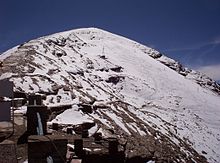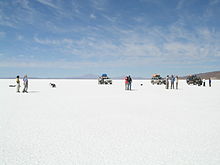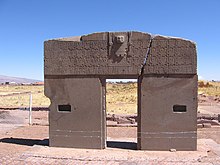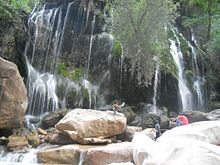Tourism in Bolivia
This article relies largely or entirely on a single source. (October 2015) |


Bolivia is a country with great tourism potential, with many attractions, due to its diverse culture, geographic regions rich history and food.



Visitor statistics
Most visitors arriving to Bolivia were from the following countries of nationality:[2]
| Country | 2016 | 2015 | 2014 |
|---|---|---|---|
| 293,458 | 238,141 | 242,075 | |
| 271,046 | 293,466 | 314,119 | |
| 104,463 | 102,624 | 116,664 | |
| 86,487 | 96,205 | 101,890 | |
| 58,403 | 59,129 | 59,871 | |
| 37,626 | 34,066 | 33,967 | |
| 33,990 | 32,620 | 33,403 | |
| 30,238 | 34,159 | 30,182 | |
| 29,575 | 24,314 | 25,560 | |
| 19,743 | 17,585 | 18,196 | |
| Total | 1,177,455 | 1,131,441 | 1,180,450 |
Heritages
In the country there are six World Heritages declared by the UNESCO:
- The ruins of the city of Tiwanaku, one of the cradles of human civilization, and the oldest of all America as it existed for 27 centuries.
- The city of Potosí, historical city by its religious and civic monuments, its streets, its people and of course, by its majestic and imposing Cerro Rico discovered the year of 1545, today become a national icon.
- The Amazon, the great lung of the planet, a sanctuary for wildlife.
- Noel Kempff Mercado National Park, representative place of the Amazon and its immense biodiversity, located on a large plateau, covered by vast forests and magnificent waterfalls.
- Madidi National Park, the most diverse place in Bolivia, declared by National Geographic, one of the 20 best places to visit in the world.
- Toro Toro National Park, where found paleontological wealth (thousands of dinosaurs footprints), caves, waterfalls, rock paintings and other places of interest are.
- The Jesuit Missions of Chiquitos, the only active missions of all of South America.
- The Fort Samaipata, the big rock carved by the Incas in the foothills of the Andes as the limit of his empire.
- The Carnival of Oruro, a great festival where Catholicism is mixed with pagan.
Destination

Lake Titicaca, the world's highest navigable lake.
- The Isla del Sol, the sacred place of the Incas and birthplace of the founders of the Inca Empire, Manco Cápac and Mama Ocllo
- The Isla de la Luna, another sacred place of the Incas near the Isla del Sol.
- Copacabana, a small town on the shores of Titicaca, home to the Virgin of Copacabana, crowned queen of Bolivia.
- The Andes, the largest mountain range in the world spanning the entire continent, and has exceptionally attractive regions:
- The highest ski slope in the world, called Chacaltaya.
- The highest mountain in the country: Nevado Sajama, with the highest forest in the world.
- The salt flats of Uyuni and Coipasa, the largest salt flats in the world.
- Bolivia also is the only country in the world in having the only hotel totally fabricated of salt, found in the Uyuni.
- The lakes Green lake and Red Lagoon, the sanctuary of the Andean flamingos with one of the largest active volcanoes in the world, the Licancabur.

- The historic cities of:
- Potosí with its Cerro Rico, formerly the largest deposits of silver of the world.
- Sucre, the capital city of the four names, in which up the first cry for freedom in South America, and is also home to one of the oldest universities in the Americas.
- Cal Orcko is paleontological site, found in the quarry of a cement factory, in the Department of Chuquisaca. It is the site with footprints of dinosaurs most important in the world, containing over 5,000 footprints of 294 species of dinosaurs.
- Casa de la Libertad, where the Declaration of Independence of Bolivia remains.
- La Recoleta, a Franciscan monastery, one of the first in the city.
- The Madidi National Park considered by National Geographic as one of the imprescidibles places to visit in the world, is part of the circuit of tourism in Bolivia. It is characterized by being one of the most biodiverse parks, flora, and fauna as well as ecological levels as it goes from the perpetual snows to the Amazon basin and harboring ethnic communities in its territory.
- The Noel Kempff Mercado National Park located in the department of Santa Cruz, on 13 December 1991 was declared a World Heritage Site. The camps Flor de Oro (the principal) and Los Fierros have tourist infrastructure.
In recent years, several scientific works, as James M. Allen, locate the lost continent of Atlantis in the Bolivian altiplano (specifically Pampa Aullagas, Oruro Department). These facts have led to a growing interest focused on the important archaeological riches.
See also
- Visa policy of Bolivia
- List of national parks of Bolivia
- Visitor attractions in Bolivia (category)
- Sustainable Bolivia
- Aquicuana Reserve
References
- ^ "Salar Uyuni" (in Spanish). 2011. Retrieved 12 October 2011.[permanent dead link]
- ^ Estadísticas por Actividad Económica. Turísmo
External links
Wikivoyage has a travel guide for Bolivia.
- Tourism in Bolivia
- Bolivia Insider Travel Guide
 Media related to Tourism in Bolivia at Wikimedia Commons
Media related to Tourism in Bolivia at Wikimedia Commons

